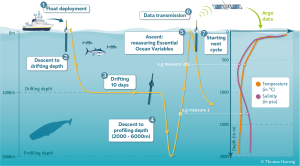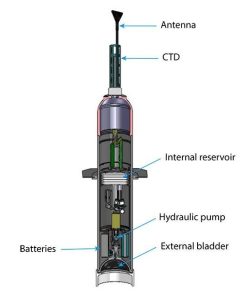
@oceannetworks.ca
VICTORIA – Ocean Networks Canada (ONC) has expanded the reach of Pacific Ocean monitoring with the deployment of new deep-sea Argo floats that collect vital ocean data while traveling up and down through the water column, the space between the sea surface and the seafloor.
The introduction of these drifting autonomous “droids of the deep” brings a new dimension to ONC’s existing deep ocean observing system in the Pacific, NEPTUNE, (North East Pacific Time-series Undersea Networked Experiments), an 800-plus-kilometre cabled observatory located on the seafloor off the west coast of Canada.
Five floats have been deployed in the northeast Pacific this year, between latitudes of 49.57° and 53.18° N, during expeditions led by Fisheries and Oceans Canada. They are now successfully transmitting ocean data that are open and accessible, expanding Canadian contributions to the international Argo program.
ONC’s new NKE Deep ARVORs floats have a vertical range of four kilometres—double the depth of most other operational floats. There are approximately 3,800 floats currently operational in the global ocean. ONC’s floats are the first to explore the northeast Pacific region below two-kilometre depths while equipped with a sensor that measures dissolved oxygen.
“The data from these floats will help researchers assess dynamics in the distribution of low oxygen waters in this region,” says ONC senior staff scientist Kohen Bauer. “The deep waters of the northeast Pacific have been losing oxygen due to climate change, which threatens ecosystem stability. The Deep Argo floats are providing measurements of dissolved oxygen more frequently and over a larger area than previously established, allowing us to better monitor critical changes in environmental conditions.”
Other metrics captured by the floats are temperature (heat storage), seawater salinity, pressure and the amount of oxygen gas in seawater, which most marine species rely on to survive.
ONC President and Chief Executive Officer Kate Moran says more than half of the ocean’s volume lies below 2,000 metres, so these deep floats will advance understanding of the changes occurring within the ocean interior, including impacts of climate warming.
“NEPTUNE observatory, for example, helped identify an extreme low oxygen (i.e. hypoxia) event in August 2021 along the southern British Columbia continental shelf. The addition of the deep floats will give us a wider geographic picture of these types of events,” she says. “With early detection, there is potential for protecting coastal aquaculture industry resources before low oxygen conditions emerge.”

oceannetworks.ca
The battery powered ARVORs travel up and down using a mechanism that controls their buoyancy–allowing them to ascend and descend through the water column. When the float breaches the surface, it connects via satellite to the global Argo data portal to transmit the collected data before beginning the cycle again.
The data from the ONC floats are contributing to Argo Canada and are accessible to all via the international Argo program, which is bringing more certainty to global heat storage estimates and therefore projections of sea level rise. Argos can also help identify ocean heat waves, and salinity data allows changes in global rainfall patterns and ocean circulation oceannetworks.ca to be studied. ONC is planning future deployments of more NKE Deep ARVORS.
This research aligns with UVic’s commitment to the United Nations Sustainable Development Goals, and with its strengths in climate action, life below water, life on land, and sustainable cities and communities. Read more at uvic.ca/IMPACT.
Source: oceannetworks.ca


